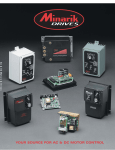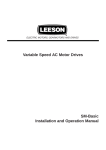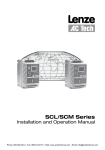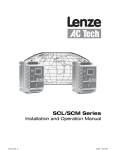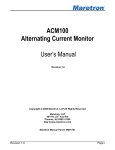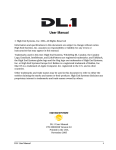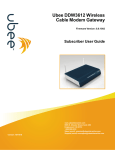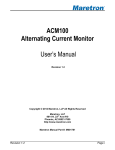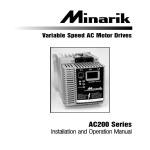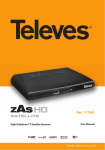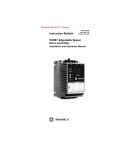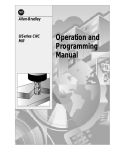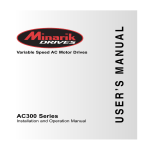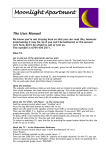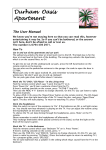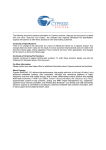Download User`s Manual - Minarik Drives
Transcript
Operation Manual
ACM100 Series
ACM100 Series Sub-Micro Drive
Copyright © 2003 by
Minarik Corporation
All rights reserved. No part of this manual may be reproduced or transmitted in any form
without written permission from Minarik Corporation. The information and technical
data in this manual are subject to change without notice. Minarik Corporation and its
Divisions make no warranty of any kind with respect to this material, including, but not
limited to, the implied warranties of its merchantability and fitness for a given purpose.
Minarik Corporation and its Divisions assume no responsibility for any errors that may
appear in this manual and make no commitment to update or to keep current the
information in this manual. MVD011403
Printed in the United States of America.
ACM100 Series User’s Manual
3
Table of Contents
1.0
GENERAL . . . . . . . . . . . . . . . . . . . . . . . . . . . . . . . . . 5
2.0
ACM100 DIMENSION. . . . . . . . . . . . . . . . . . . . . . . . 8
3.0
ACM100 MODEL DESIGNATION CODE . . . . . . . . 10
4.0
ACM100 SPECIFICATIONS . . . . . . . . . . . . . . . . . . 10
5.0
ACM100 RATINGS . . . . . . . . . . . . . . . . . . . . . . . . . 11
6.0
INSTALLATION . . . . . . . . . . . . . . . . . . . . . . . . . . . . 12
7.0
INPUT AC POWER REQUIREMENTS . . . . . . . . . . 13
8.0
POWER WIRING . . . . . . . . . . . . . . . . . . . . . . . . . . 17
9.0
ACM100 POWER WIRING DIAGRAM . . . . . . . . . . 19
10.0 CONTROL WIRING . . . . . . . . . . . . . . . . . . . . . . . . 20
11.0
ACM100 CONTROL WIRING DIAGRAM . . . . . . . . 24
12.0 INITIAL POWER UP AND MOTOR ROTATION . . . 28
13.0 PROGRAMMING THE ACM100 DRIVE . . . . . . . . . 30
14.0 PARAMETER MENU . . . . . . . . . . . . . . . . . . . . . . . 36
15.0 DESCRIPTION OF PARAMETERS . . . . . . . . . . . . 39
16.0 TROUBLESHOOTING . . . . . . . . . . . . . . . . . . . . . . 59
17.0 ACM100 DISPLAY MESSAGES . . . . . . . . . . . . . . . 61
4
ACM100 Series User’s Manual
THE ACM100 SERIES SUB-MICRO DRIVE
INPUT POWER
TERMINALS
DC BUS
TERMINALS
ELECTRONIC
PROGRAMMING
MODULE (EPM)
3-DIGIT LED
DISPLAY
PROGRAMMING
BUTTONS
CONTROL
TERMINAL
STRIP
OUTPUT (MOTOR) TERMINALS
ACM100 Series User’s Manual
1.0
5
GENERAL
1.1 PRODUCTS COVERED IN THIS MANUAL
This manual covers the ACM100 Series Variable Frequency Drive.
1.2 PRODUCT CHANGES
Minarik Corporation reserves the right to discontinue or make modifications
to the design of its products without prior notice, and holds no obligation to
make modifications to products sold previously. Minarik Corporation also
holds no liability for losses of any kind which may result from this action.
Instruction manuals with the most up-to-date information are available for
download from Minarik Drives website (www.minarikdrives.com).
1.3 WARRANTY
Minarik Corporation (referred to as “the Corporation”) warrants that its
manufactured products will be free from defects in workmanship and material
for twelve (12) months or 3,000 hours, whichever comes first, from date of
manufacture thereof. Within this warranty period, the Corporation will repair
or replace such products that are returned to Minarik Corporation, 901 East
Thompson Avenue, Glendale, CA 91201-2011 USA. This warranty shall
not apply to any product that has been repaired by unauthorized persons.
The Corporation is not responsible for removal, installation, or any other
incidental expenses incurred in shipping the product to and from the repair
point. This warranty is in lieu of all other warranties, expressed or implied.
No other person, firm, or corporation is authorized to assume, for Minarik
Corporation, any other liability in connection with the demonstration or sale of
its products.
1.4 RECEIVING
Inspect all cartons for damage which may have occurred during shipping.
Carefully unpack equipment and inspect thoroughly for damage or shortage.
Report any damage to carrier and/or shortages to supplier. All major
components and connetions should be examined for damage and tightness,
with special attention given to PC boards, plugs, knobs and switches.
6
ACM100 Series User’s Manual
1.5 SAFETY INFORMATION
GENERAL
All operations concerning installation and commissioning, as well as
maintenance, must be carried out by qualified, skilled personnel (IEC
364 and CENELEC HD 384 or DIN VDE 0100 and IEC report 665 or
DIN VDE 0110 and national regulations for the prevention of accidents must
be observed).
According to this basic safety information, qualified skilled personnel are
persons who are familiar with the installation, assembly, commissioning, and
operation of the product and who have the qualifications necessary for their
occuptation.
APPLICATIONS AS DIRECTED
Drive controllers are components which are designed for installation in
electrical systems or machinery. They are not to be used as applicances.
They are intended exclusively for professional and commercial purposes
according to EN 61000-3-2.
When installing the drive controllers in machines, commissioning (i.e.
the starting of operation as directed) is prohibited until it is proven that
the machine complies with the regulations of the EC Directive 98/37/EC
(Machinery Directive); EN 60204 must be observed. Commissioning (i.e.
starting of operation as directed) is only allowed when there is compliance
with the EMC Directive (89/336/EEC).
The drive controllers meet the requirements of the Low Voltage Directive -/DIN 72/23/EEC. The harmonised standards of the series EN 61800-5-1/DIN
VDE 0160 apply to the controllers.
NOTE: This is a product of the restricted sales distribution class according
to EN61800-3. In a domestic environment this product may cause radio
interference in which case the user may be required to take adequate
measures.
ELECTRICAL CONNECTION
When working on live drive controllers, applicable national regulations for the
prevention of accidents (e.g. VBG 4) must be observed.
The electrical installation must be carried out according to the appropriate
regulations (e.g. cable size, fuses, PE connection).
ACM100 Series User’s Manual
7
This manual contains information about installation in compliance with
EMC (shielding, grounding, filters and cables). These notes must also
be observed for CE-marked controllers. The manufacturer of the system
or machine is responsible for compliance with the required limit values
demanded by EMC legislation.
1.6 CUSTOMER MODIFICATION
Minarik Corporation, its sales representatives and distributors, welcome
the opportunity to assist our customers in applying our products. Many
customizing options are available to aid in this function. Minarik Corporation
cannot assume responsibility for any modifications not authorized by its
engineering department.
8
2.0
ACM100 Series User’s Manual
ACM100 SERIES DIMENSIONS
5.75
[146]
R
W
0.38 [9.5]
0.18 [4.6]
0.69 [17.5]
D
P
0.19 [4.8]
Dia. Slot
Mounting Tab Detail
ALL DIMEMSIONS IN INCHES [MILLIMETERS]
ACM100 Series User’s Manual
2.0
9
ACM100 SERIES DIMENSIONS (cont.)
INPUT
INPUT
VOLTAGE PHASE
kW
HP
MODEL
W
D
P
R
0.25
0.33
120
1
ACM100S-0.25
2.88 [74]
0.25
0.33
208/240
1
ACM112S-0.25
2.88 [74]
3.26 [83]
0.28 [7]
4.37 [111]
3.26 [83]
0.28 [7]
0.37
0.5
120
1
ACM110S-0.4
2.88 [74]
4.37 [111]
3.26 [83]
0.28 [7]
0.37
0.5
208/240
1
ACM112S-0.4
4.37 [111]
2.88 [74]
3.26 [83]
0.28 [7]
0.37
0.5
208/240
3
ACN112T-0.4
4.37 [111]
2.88 [74]
3.26 [83]
0.28 [7]
4.37 [111]
0.37
0.5
400/480
3
ACM114T-0.4
0.55
0.75
208/240
1
ACM112S-0.55
2.88 [74]
0.75
1
120
1
ACM110S-0.75
3.76 [95] 4.88 [124] 1.50 [38] 4.37 [111]
0.75
1
208/240
1
ACM112S-0.75
2.88 [74]
3.63 [92]
0.63 [16] 4.37 [111]
0.75
1
208/240
3
ACM112T-0.75
2.88 [74]
3.63 [92]
0.63 [16] 4.37 [111]
0.75
1
400/480
3
ACM114T-0.75
2.88 [74] 4.74 [120] 1.60 [41] 4.37 [111]
1.1
1.5
120
1
ACM110S-1.1
3.76 [95] 4.88 [124] 1.50 [38] 4.37 [111]
1.1
1.5
208/240
1
ACM112S-1.1
3.76 [95] 4.88 [124] 1.50 [38] 4.37 [111]
1.1
1.5
208/240
3
ACM112T-1.1
2.88 [74] 5.56 [141] 2.56 [65] 4.37 [111]
1.1
1.5
400/480
3
ACM114T-1.1
2.88 [74] 5.74 [146] 2.56 [65] 4.37 [111]
1.5
2
208/240
1
ACM112S-1.5
3.76 [95] 4.88 [124] 1.50 [38] 4.37 [111]
1.5
2
208/240
3
ACM112T-1.5
2.88 [74] 5.56 [141] 2.56 [65] 4.37 [111]
1.5
2
400/480
3
ACM114T-2.2
3.76 [95] 6.74 [171] 3.40 [86] 4.37 [111]
2.2
3
208/240
1
ACM112S-2.2
3.76 [95] 5.53 [140] 2.18 [55] 4.37 [111]
2.2
3
208/240
3
ACM112T-2.2
3.76 [95] 5.53 [140] 2.18 [55] 4.37 [111]
2.2
3
400/480
3
ACM114T-2.2
3.76 [95] 5.24 [133] 1.90 [48] 4.37 [111]
4.0
5
208/240
3
ACM112T-3.7
3.76 [95]
6.74[171]
3.40 [86]
3.25 [83]
4.0
5
400/480
3
ACM114T-3.7
3.76 [95]
6.74[171]
3.40 [86]
3.25 [83]
2.88 [74] 3.94 [100] 0.80 [20] 4.37 [111]
3.63 [92]
0.63 [16] 4.37 [111]
10
3.0
ACM100 Series User’s Manual
ACM100 MODEL DESIGNATION CODE
ACM
110
S
0.25
SERIES
ACM = ACM SERIES VARIABLE SPEED AC MOTOR DRIVE
INPUT VOLTAGE
110 = 120 VAC
112 = 208/240 VAC
114 = 400/480 VAC
INPUT PHASE
S = SINGLE PHASE INPUT ONLY
T = THREE PHASE INPUT ONLY
RATING
0.25 = 0.33 HP (0.25 kW)
0.4 = 0.50 HP (0.37 kW)
0.55 = 0.75 HP (0.55 kW)
0.75 = 1 HP (0.75 kW)
4.0
1.1 = 1.5 HP (1.1 kW)
1.5 = 2 HP (1.5 kW)
2.2 = 3 HP (2.2 kW)
3.7 = 5 HP (4.0 kW)
ACM100 SPECIFICATIONS
Storage Temperature
Ambient Operating Temperature
Ambient Humidity
Altitude
Input Line Voltage
Input Voltage Tolerance
Input Frequency Tolerance
Output Wave Form
Output Frequency
Carrier Frequency
Service Factor
Efficiency
Power Factor (displacement)
Overload Current Capacity
Speed Reference Follower
Digital Output
-20° to 70°C
0° to 40°C (derate 5% per °C above 40°C, up to 55°C max)
<95% (non-condensing)
3300 ft (1000 m) above sea level (derate 5% per additional 3300 ft)
120, 208/240, 400/480 VAC
+10%, -15%
48 to 62 Hz
Sine Coded PWM
0 - 240 Hz
4 kHz to 10 kHz (10 kHz requires derating; see parameter P02)
1.00 (up to 8 kHz carrier; derate for 10 kHz; see parameter P02)
Up to 98%
0.96 or better
150% for 60 seconds, 180% for 30 seconds
0 - 10 VDC, 4 - 20 mA
(1) Normally open relay; contacts rated 3 amsp at 250 VAC (1)
Digital output (current-sourching); rated 50 mA at 12 VDC
Earth Leakage Current (EN50178)
Single-Phase: > 3.5 mA to PE
3-phase: <3.5 mA to PE
ACM100 Series User’s Manual
11
5.0 ACM100 RATINGS
ACM MODEL
NUMBER
(NOTE 1)
FOR MOTORS
RATED
HP
Kw
120 VAC INPUT MODELS
ACM110S-0.25
0.33
0.25
ACM110S-0.4
0.5
0.37
ACM110S-0.75
1
0.75
ACM110S-1.1
1.5
1.1
208/240 VAC INPUT MODELS
ACM112S-0.25
0.33
0.25
ACM112S-0.4
0.5
0.37
ACM112T-0.4
0.5
0.37
ACM112S-0.55
0.75
0.55
ACM112S-0.75
1
0.75
ACM112T-0.75
1
0.75
ACM112S-1.1
1.5
1.1
ACM112T-1.1
1.5
1.1
ACM112S-1.5
2
1.5
ACM112T-1.5
2
1.5
ACM112S-2.2
3
2.2
ACM112T-2.2
3
2.2
ACM112T-3.7
5
4
400/480 VAC INPUT MODELS
ACM114T-0.4
0.5
0.37
ACM114T-0.75
1
0.75
ACM114T-1.1
1.5
1.1
ACM114T-1.5
2
1.5
ACM114T-2.2
3
2.2
ACM114T-3.7
5
4
OUTPUT
(3 PHASE)
INPUT (50-60 Hz)
INPUT
PHASE
CURRENT
(AMPS)
1
1
1
1
120 VAC
6.8
9.2
16.6
24
1
1
3
1
1
3
1
3
1
3
1
3
3
3
3
3
3
3
3
208/240 VAC
3.9/3.4
5.8/5.0
3.1/2.7
6.9/6.0
10.6/9.2
5.8/5.1
13.9/12.0
8.0/6.9
18.4/16.0
9.1/7.9
24/21
12.4/10.8
19.6/17.1
400/480 VAC
1.6/1.4
3.0/2.5
4.3/3.6
4.8/4.0
6.4/5.4
10.6/8.8
POWER
(Kva)
0.8
1.1
2
2.9
0.8
1.2
1.1
1.4
2.2
2.1
2.9
2.9
3.1
3.3
4.1
4.5
7.1
1.1
2.1
3.0
3.3
4.5
7.1
CURRENT
(AMPS)
0 - 230 VAC
1.7
2.4
4.2
6
0-208/230 VAC
1.9/1.7
2.8/2.4
2.8/2.4
3.7/3.2
4.8/4.2
4.8/4.2
6.9/6.0
6.9/6.0
8.1/7.0
8.1/7.0
11.0/9.6
11.0/9.6
17.5/15.2
0-400/460 VAC
1.3/1.1
2.5/2.1
3.6/3.0
4.1/3.4
5.8/4.8
9.4/7.8
HEAT LOSS
(WATTS)
(NOTE 2)
NOTE 1: See Section 3.0 for model number breakdown.
NOTE 2: Values are worst-case (not typical) for 6 kHz carrier frequency at full speed and full load.
29
33
57
86
23
31
31
34
47
47
68
68
71
71
108
108
173
31
47
58
63
92
155
12
ACM100 Series User’s Manual
6.0
INSTALLATION
NOTE: ACM100 Series drives are intended for inclusion within other
equipment, by professional electrical installers according to EN 61000-3-2.
They are not intended for stand-alone operation.
WARNING: Drives must not be installed where subjected to adverse
environmental conditions such as: combustible, oily, or hazardous vapors or
dust; excessive moisture or dirt; vibration; excessive ambient temperatures.
Consult Minarik Corporation for more information on the suitability of a drive
to a particular environment.
ACM100 Series modes are suitable for UL pollution degree 2 environment only,
and MUST be installed in an electrical enclosure which will provide complete
mechanical protection and will maintain the internal temperature within the drive’s
ambient operating temperature rating. All drive models MUST be mounted in a
vertical position for proper heatsink cooling.
Maintain a minimum spacing around the drive of at least 1 inch (25 mm) on each
side and 2 inches (50 mm) on the top and bottom. Allow more spacing if the drive
is mounted next to other heat-producing equipment. Do not mount drives above
other drives or heat producing equipment. Fans or blowers should be used to
insure proper cooling in tight quarters.
In order to properly size an enclosure, the heat generated by the drive(s) must be
known. Refer to the HEAT LOSS column in Section 5.0 ACM100 RATINGS. An
enclosure manufacturer can then determine the required enclosure size based
on the total heat generated inside the enclosure (from the drive(s) and other heat
sources), the maximum allowable temperature inside the enclosure, the maximum
ambient temperature outside the enclosure, and the enclosure properties.
The ACM100 Series is UL approved for solid state motor overload protection.
Therefore, a separate thermal overload relay is not required for single motor
applications.
6.1 INSTALLATION AFTER A LONG PERIOD OF STORAGE
WARNING! Severe damage to the drive can result if it is operated after a long
period of storage or inactivity without reforming the DC bus capacitors!
ACM100 Series User’s Manual
13
If input power has not been applied to the drive for a period of time exceeding
three years (due to storage, etc.), the electrolytic DC bus capacitors within the
drive can change internally, resulting in excessive leakage current. This can result
in premature failure of the capacitors if the drive is operated after such a long
period of inactivity or storage.
In order to reform the capacitors and prepare the drive for operation after a long
period of inactivity, apply input power to the drive for 8 hours prior to actually
operating the motor.
7.0
INPUT AC POWER REQUIREMENTS
WARNING! Hazard of electrical shock! Capacitors retain charge after power
is removed. Disconnect incoming power and wait until the voltage between
terminals B+ and B- is 0 VDC before servicing the drive.
The input voltage must match the nameplate voltage rating of the drive. Voltage
fluctuation must not vary by greater than 10% overvoltage or 15% undervoltage.
NOTE: Drives with dual input voltage ratings must be programmed for the proper
supply voltage (refer to Parameter 01 - LINE VOLTAGE SELECTION in Section
15.0 - DESCRIPTION OF PARAMETERS).
The drive is suitable for use on a circuit capable of delivering not more than 5,000
RMS symmetrical amperes at the drive’s rated voltage.
If the kVA rating of the AC supply transformer is greater than 10 times the input
kVA rating of the drive(s), an isolation transformer, or 2-3% input line reactor must
be added to the line side of the drive(s).
Three phase voltage imbalance must be less than 2.0% phase to phase.
Excessive phase to phase imbalance can cause severe damage to the drive.
Motor voltage should match line voltage in normal applications. The drive’s
maximum output voltage will equal the input voltage. Use extreme caution when
using a motor with a voltage rating which is different from the input line voltage.
14
ACM100 Series User’s Manual
7.1 INPUT VOLTAGE RATINGS
ACM110S Series drives are rated for 120 VAC single phase, 50-60 Hz input. The
drive will function with input voltage of 120 VAC (+10%, -15%) at 48 to 62 Hz.
ACM112S Series drives are rated for 208/240 VAC, single phase, 50-60 Hz input.
The drive will function with input voltage of 208 to 240 VAC (+10%, -15%), at 48
to 62 Hz.
ACM112T Series drives are rated for 208/240 VAC, three phase, 50-60 Hz input.
The drive will function with input voltage of 208 to 240 VAC (+10%, -15%) at 48 to
62 Hz.
ACM114T Series drives are rated for 400/480 VAC, three phase, 50-60 Hz input.
The drive will function with input voltage of 400 to 480 VAC (+10%, -15%) at 48 to
62 Hz.
NOTE: Parameter 01 - LINE VOLTAGE SELECTION must be programmed
according to the applied input voltage. See Section 15.0 - DESCRIPTION OF
PARAMETERS.
7.2 INPUT FUSING AND DISCONNECT REQUIREMENTS
A circuit breaker or a disconnect switch with fuses must be provided in
accordance with the National Electric Code (NEC) and all local codes. Refer to
the following tables for proper fuse/circuit breaker ratings and wire sizes.
INPUT FUSE & CIRCUIT BREAKER RATINGS
120 VAC 1 PHASE
208/240 VAC 3 PHASE
400/480 VAC 3 PHASE
ACM110S-0.25
10A
ACM112T-0.4
10A
ACM114T-0.4
ACM110S-0.4
15A
ACM112T-0.75
10A
ACM114T-0.75
10A
10A
ACM110S-0.75
25A
ACM112T-1.1
12/10A
ACM114T-1.1
10A
ACM110S-1.1
35A
ACM112T-1.5
15/12A
ACM114T-1.5
10A
ACM112T-2.2
20/15A
ACM114T-2.2
10A
ACM112T-3.7
30/25A
ACM114T-3.7
15/12A
ACM100 Series User’s Manual
15
NOTE 1: Applicable national and local electrical codes take precedence
over recommendations in these tables. Use UL Class CC fast-acting, current
limiting type fuses. Select fuses with low I2T values, rated at 200,000 AIC.
Recommended fuses are Bussman KTK-R, JJN, and JJS. Similar fuses with
equivalent ratings by other manufacturers may be also acceptable.
NOTE 2: This product can cause a DC current in the protective conductor. Where
a residual current device (RCD) is used for protection in case of direct or indirect
contact, only an RCD of Type B is allowed on the supply side of this product.
Otherwise, another protective measure shall be applied, such as separation from
the environment by double or reinforced insulation, or isolation from the supply
system by a transformer.
Observe the following when using RCDs:
1. Only install the RCD between the supply mains and drive controller.
2. The RCD can be activated by:
- capacitive leakage currents between the cable screens during
operation (especially with long, screened motor cables)
- connecting several drives to the mains at the same time
- additional RFI filters
7.3 INPUT WIRE SIZE REQUIREMENTS
120 VAC 1 PHASE
MODEL
ACM110S-0.25
208/240 VAC 3 PHASE
AWG mm2
14
2.5
400/480 VAC 3 PHASE
MODEL
AWG
ACM112T-0.4
14
mm
2.5
2
MODEL
AWG
ACM114T-0.4
14
mm
2.5
ACM110S-0.4
14
2.5
ACM112T-0.75
14
2.5
ACM114T-0.75
14
2.5
ACM110S-0.75
12
4.0
ACM112T-1.1
14
2.5
ACM114T-1.1
14
2.5
ACM110S-1.1
10
6.0
ACM112T-1.5
14
2.5
ACM114T-1.5
14
2.5
ACM112T-2.2
14
2.5
ACM114T-2.2
14
2.5
ACM112T-3.7
12
4.0
ACM114T-3.7
14
2.5
2
16
ACM100 Series User’s Manual
7.4 INSTALLATION ACCORDING TO EMC REQUIREMENTS
The ACM100 Series can be installed to meet the European standards for
Electromagnetic Compatibility (EMC) requirements. These requirements govern
the permissible electromagnetic emissions and immunity, both radiated and
conducted, of a drive system.
The EMC requirements apply to
the final installation in its entirety,
not to the individual components
used. Because every installation
is different, the recommended
installation should follow these
guidelines as a minimum.
Additional equipment (such as
ferrite core absorbers on power
conductors) or alternative wiring
practices may be required to meet
conformance in some installations.
Filter: The input to the drive ( or
group of drives) must include a
filter to reduce the electrical noise
reflected back to the AC Line.
The ACM100 series drive can
be installed to meet these same
standards when used with an
appropriately installed external line
filter.
Installation: Shielded cable must
be used for all control and power
cables and exposed wiring must
be kept as short as possible. The
figure above shows the control
cable (B) and motor cable (C) with the shield grounded with clamps (A) to a
grounded, electrically conductive mounting panel (D). The motor cable must be of
a low capacitance specification:
core/core < 75 pF/m, core/shield < 150 pF/m
ACM100 Series User’s Manual
8.0
17
POWER WIRING
WARNING! Hazard of electrical shock! Capactors retain charge after power
is removed. Disconnect incoming power and wait until the voltage between
terminals B+ and B- is 0 VDC before servicing the drive.
Note drive input and output current ratings and check applicable electrical codes
for required wire type and size, grounding requirements, over-current protection,
and incoming power disconnect, before wiring the drive. Size conservatively to
minimize voltage drop.
Strip off 0.20 to 0.25 inches (5 to 6 mm) of insulation for input power, output
power, and DC Bus wiring. The input power, output power, and DC Bus terminals
must be tightened to a torque of 4.5 lb-in (0.5 Nm).
Input fusing and a power disconnect switch or contactor MUST be wired in series
with termianls L1 and L2/N (on single-phase input modesl), or terminals L1, L2,
and L3 (on three-phase input models). This disconnect must be used to power
down the drive when servicing, or when the drive is not to be operated for a long
period of time, but should not be used to start and stop the motor.
Repetitive cycling of a disconnect or input contactor (more than once every two
minutes) may cause damage to the drive.
18
ACM100 Series User’s Manual
8.1 INPUT AND OUTPUT WIRING
On single phase input models, wire the input power to terminals L1 and L2/N. On
three phase input models, wire the input power to terminals L1, L2, and L3. Refer
to Section 9.0 - ACM100 POWER WIRING DIAGRAM.
All three power output wires, from terminals U, V, and W to the motor, must be
kept tightly bundled and run in a separate conduit away from all other power and
control wiring.
It is not recommended to install contactors or disconnect switches between the
drive and motor. Operating such devices while the drive is running can potentially
cause damage to the drive’s power components. If such a device is required, it
should only be operated when the drive is in a STOP state. If there is potential for
the device to be opened while the drive is running, the drive must be programmed
for COAST to stop (see Parameter 4 - STOP METHOD), and an auxiliary contact
on the device must be interlocked with the drive’s run circuit. This will give the
drive a stop command at the same time the device opens, and will not allow the
drive to start again until the device is closed.
ACM100 Series User’s Manual
9.0
19
ACM POWER WIRING DIAGRAM
INPUT
(SINGLE-PHASE MODELS ONLY)
INPUT
(THREE-PHASE MODELS ONLY)
INPUT AC
VOLTAGE
INPUT AC
VOLTAGE
PE Lug
on Heatsink
L1
L2/N
PE
B-
B+
L1
L2
L3
B-
B+
OUTPUT (ALL MODELS)
U
V
PES
W
PE
PE
WARNING! DO NOT connect
incoming AC power to output
terminals U, V, W, or terminals
B+, B-. This will result in severe
damage to the drive!
PES
3 PHASE
AC MOTOR
NOTES:
1. WIRE AND GROUND IN ACCORDANCE WITH NEC OR CEC, AND ALL
APPLICABLE LOCAL CODES.
2. Motor wires MUST be run in a separate steel conduit away from control wiring
and incoming AC power wiring.
3. Do not install contactors between the drive and the motor without consulting
Minarik Corporation for more information. Failure to do so may result in drive
damage.
4. Use only UL and CSA listed and approved wire.
5. Minimum wire voltage rating is 300 V for 120, 208, and 240 VAC systems, and
600 V for 400 and 480 VAC systems.
6. Wire gauge must be based on a minimum of 125% of the rated input/output
current of the drive, and a minimum 75°C insulation rating. Use copper wire only.
7. Leakage current may exceed 3.5 mA AC. Minimum size of the protective earth
conductor shall comply with local safety regulations for high leakage current equipment.
20
ACM100 Series User’s Manual
10.0
CONTROL WIRING
10.1 CONTROL WIRING VS. POWER WIRING
External control wiring MUST be run in a separate conduit away from all other
input and output power wiring. If control wiring is not kept separate from power
wiring, electrical noise may be generated on the control wiring that will cause
erratic drive behavior. Use twisted wires or shielded cable grounded at the drive
chassis ONLY. Recommended control wire is Belden 8760 (2-wire) or 8770 (3wire) or equivalent. NOTE: Control terminals provide basic isolation (insulation
per EN 61800-5-1). Protection against contact can only be assured by additional
measures e.g. supplemental insulation.
Strip off 0.20 to 0.25 inches (5 to 6 mm) of insulation for control wiring, and torque
the control terminals to 2 lb-in (0.2 Nm). Be careful not to overtorque the control
terminals, as this will cause damage to the terminal strip. This is not covered
under warranty and can only be repaired by replacing the control board.
10.2 TB-2: CIRCUIT COMMON
The TB-2 terminal is used as circuit common for the analog speed reference
inputs. If necessary TB-2 may be connected to chassis ground.
10.3 SURGE SUPPRESSION ON RELAYS
Current and voltage surges and spikes in the coils of contactors, relays, solenoids,
etc, near or connected to the drive, can cause erratic drive operation. Therefore,
a snubber circuit should be used on coils associated with the drive. For AC coils,
snubbers should consist of a resistor and a capacitor in series across the coil.
For DC coils, a free-wheeling or flyback diode should be placed across the coil.
Snubbers are typically available from the manufacturer of the device.
10.4 START/STOP CONTROL
There are various control schemes that allow for 2-wire and 3-wire Start/Stop
circuits. Refer to the wiring diagrams in Section 11.0 - ACM CONTROL WIRING
DIAGRAMS
ACM100 Series User’s Manual
21
10.5 SPEED REFERENCE SIGNALS
The drive allows for three analog speed reference inputs:
SPEED POT
Connect the wiper of a speed pot to terminal TB-5, and
connect the high and low end leads to terminals TB-6 and
TB-2, respectively. The speed pot can be 2.5k ohm up to 10k
ohm.
0 - 10 VDC
Wire the positive to terminal TB-5 and the negative to terminal
TB-2. TB-5 input impedance is 120 kilohms.
4 - 20 mA
Wire the positive to terminal TB-25 and the negative to
terminal TB-2. The TB-25 input impedance is 250 ohms.
10.6 SPEED REFERENCE SELECTION
If an analog speed reference input is used to control the drive speed, terminal
TB-13A, 13B, or 13E (Parameter 10, 11, or 12) may be programmed as the input
select for the desired analog input signal. When that TB-13 terminal is then
closed to TB-11, the drive will follow the selected analog speed reference input.
If an analog speed reference input is not selected on the terminal strip using
TB-13A, 13B, or 13E, speed control will default to STANDARD mode, which is
governed by the setting of STANDARD SPEED SOURCE (Parameter 05). The
STANDARD SPEED SOURCE can be the s and t buttons on the front of the drive,
PRESET SPEED #1 (Parameter 31), a 0 - 10 VDC signal, or 4 - 20 mA signal.
0 - 10 VDC and 4 - 20 mA INPUT SIGNALS
TB-13A, TB-13B, and TB-13 E can all be programmed to select a 0 - 10
VDC or 4 - 20 mA analog speed preference input.
PRESET SPEEDS
TB-13A can be programmed to select PRESET SPEED #1 (04), TB-13B
to select PRESET SPEED #2 (04), and TB-13E to select PRESET SPEED
#3 (04). There are a total of seven preset speeds, which are activated by
different combinations of contact closures between TB-13A, 13B, 13E, and
TB-11. Refer to Parameters 31-37 in Section 15.0 - DESCRIPTION OF
PARAMETERS.
22
ACM100 Series User’s Manual
JOG
TB-13B can be programmed to select either JOG FORWARD (07) or JOG
REVERSE (08). The Jog speed is set by PRESET SPEED #2 (Parameter
32). Close TB-13B to TB-11 to JOG, and open the contact to STOP.
WARNING! When operating in JOG mode, the STOP signal and the AUXILIARY
STOP function (see Parameters 10-12) WILL NOT stop the drive. To stop the
drive, remove the JOG command.
JOG REVERSE will operate the drive in reverse rotation even if ROTATION
DIRECTION (Parameter 17) is set to FORWARD ONLY.
NOTE: If the drive is commanded to JOG while running, the drive will enter
JOG mode and run at PRESET SPEED #2. When the JOG command is removed,
the drive will STOP.
MOTOR OPERATED POT (MOP) FLOATING POINT CONTROL
TB-13B and TB-13E are used for this function, which controls the drive
speed using contacts wired to the terminal strip. Program TB-13B for
DECREASE FREQ (05), and program TB-13E for INCREASE FREQ (05).
Closing TB-13B to TB-11 will cause the speed setpoint to increase until the
contact is opened. The INCREASE FREQ function will only operate while
the drive is running.
NOTE: If TB-13A, TB-13B, and TB-13E are all programmed to select speed
references, and two or three of the terminals are closed to TB-11, the higher
terminal has priority and will override the others. For example, if TB-13A is
programmed to select 0 - 10 VDC, and TB-13E is programmed to select PRESET
SPEED #3, closing both terminals to TB-11 will cause the drive to respond to
PRESET SPEED #3, because TB-13E overrides TB-13A.
The exception to this is the MOP function, which requires the use of TB-13B
and TB-13E. This leaves TB-13A to be used for some other function. If TB13A is programmed for a speed reference, and TB-13A is closed to TB-11,
TB-13A will override the MOP function.
ACM100 Series User’s Manual
23
10.7 DRIVE STATUS DIGITAL OUTPUTS
There is one Form A relay at terminals TB-16 and TB-17. Relay contacts are
rated 3 amps at 250 VAC.
Terminal TB-13E can also be configured as a digital output. This output circuit is
a current-sourcing type rated at 12 VDC and 50 mA maximum.
The Form A relay and digital output can be programmed to indicate any of the
following: RUN, FAULT, INVERSE FAULT, FAULT LOCKOUT, AT SPEED,
ABOVE PRESET SPEED #3, CURRENT LIMIT, AUTO SPEED MODE, and
REVERSE. Refer to Parameters 06 and 12 in Section 15.0 - DESCRIPTION OF
PARAMETERS.
The digram below illustrates how TB-13E, when configured as a digital output, can
be used to drive an external relay:
ACM100 TERMINAL STRIP
DIODE SNUBBER
(1N4148 or Equivalent)
TB-13E
RELAY COIL
TB-2
24
ACM100 Series User’s Manual
11.0
ACM100 CONTROL WIRING DIAGRAMS
11.1 ACM100 TERMINAL STRIP
Shown below is the control terminal strip, along with a brief description of the
function of each terminal. The following wiring diagram examples provide a quick
reference to wire the drive for the most common configurations.
4 - 20 mA INPUT
16
17
+
25
TB-13E FUNCTION SELECT
13B 13E
TB13B FUNCTION SELECT
+
SPEED POT POWER SUPPLY
11 13A
TB-13A FUNCTION SELECT
0 - 10 VDC INPUT
-
2
DIGITAL INPUT REFERENCE
6
1
RUN
5
SIGNAL COMMON
FORM A
RELAY
MAINTAINED
RUN/STOP
CONTACT
NOTE: The function of termianls TB-13A, 13B, 13E and the Form A relay at
terminals 16 and 17 are dependent on the programming of certain parameters.
Refer to Section 15.0 - DESCRIPTION OF PARAMETERS
ACM100 Series User’s Manual
25
11.2 TWO-WIRE START/STOP CONTROL
16
17
4 - 20 mA INPUT
25
+
TB-13E FUNCTION SELECT
SPEED POT POWER SUPPLY
13B 13E
TB13B FUNCTION SELECT
0 - 10 VDC INPUT
MAINTAINED
RUN/STOP
CONTACT
(FORWARD)
1 1 13A
TB-13A FUNCTION SELECT
(RUN REVERSE)
SIGNAL COMMON
-
2
DIGITAL INPUT REFERENCE
6
1
RUN
5
+
FORM A
RELAY
MAINTAINED
RUN/STOP
CONTACT
(REVERSE)
NOTES:
1. Close TB-1 to TB-11 to RUN, and open to STOP. TB-1 functions as a
RUN input for two-wire start/stop circuits, and a STOP input for three-wire start/
stop circuits. Refer to Section 11.3.
2. If reverse direction is required, set ROTATION (Parameter 17) to FORWARD
AND REVERSE (02), and program TB-13A (Parameter 10) to RUN REVERSE
(06). Close TB-13A to TB-11 to RUN in the reverse direction, and open to
STOP.
3. For 0 - 10 VDC or 4 - 20 mA speed control, set STANDARD SPEED SOURCE
(Parameter 05) to 0 - 10 VDC (03) or 4 - 20 mA (04).
ACM100 Series User’s Manual
11.3 THREE-WIRE START/STOP CONTROL
REV
MOMENTARY
STOP CONTACT
16
17
4 - 20 mA INPUT
25
+
TB13B FUNCTION SELECT
SPEED POT POWER SUPPLY
13B 13E
TB-13E FUNCTION SELECT
(START FORWARD)
-
11 13A
TB-13A FUNCTION SELECT
(START REVERSE)
6
0 - 10 VDC INPUT
2
DIGITAL INPUT REFERENCE
5
+
1
RUN
FORM A
RELAY
SIGNAL COMMON
26
FWD
MOMENTARY
START CONTACT
NOTES:
1. Program TB-13E (Parameter 12) for START FORWARD (06).
2. If reverse direction is required, set ROTATION (Parameter 17) to FORWARD
AND REVERSE (02), and program TB-13A (Parameter 10) for START
REVERSE (07).
3. Momentarily close TB-13E to TB-11 to START in the forward direction, or close
TB-13A to TB-11 to START in the reverse direction. Momentarily open TB-1 to
TB-11 to STOP the drive.
4. For 0 - 10 VDC or 4 - 20 mA speed control, set STANDARD SPEED SOURCE
(Parameter 05) to 0 - 10 VDC (03) or 4 - 20 mA (04).
ACM100 Series User’s Manual
27
11.4 PRESET SPEEDS AND SPEED POT
(WITH TWO-WIRE START/STOP CONTROL)
13B 13E
TB13B FUNCTION SELECT
0 - 10 VDC INPUT
11 13A
25
16
17
TB-13E FUNCTION SELECT
RUN
6
TB-13A FUNCTION SELECT
5
DIGITAL INPUT REFERENCE
2
SPEED POT POWER SUPPLY
1
SIGNAL COMMON
FORM A
RELAY
SPEED
POT
MAINTAINED
RUN/STOP
CONTACT
NOTES:
1. For preset speed control, all or some of the TB-13 terminals must be
programmed as preset speed selects. If only two or three preset speeds are
required, only two of the TB-13 terminals must be used. Refer to the table in
the description of Parameters 31-37 in Section 15.0
2. Program the PRESET SPEEDS (Parameters 31-37) to the desired values.
3. If speed pot control is desired when none of the preset speeds are selected
(all preset speed selects are open to TB-11, set STANDARD SPEED SOURCE
(Parameter 05) to 0 - 10 VDC (03).
28
ACM100 Series User’s Manual
12.0
INITIAL POWER UP AND MOTOR ROTATION
WARNING! DO NOT connect incoming AC power to output terminals U, V,
and W or terminals B+, B-. Do not continuously cycle input power to the drive
more than once every two minutes. This will result in severe damage to the
drive.
WARNING! Hazard of electrical shock! Wait three minutes after disconnecting
incoming power before servicing the drive. Capacitors retain charge after the
power is removed.
WARNING! Severe damage to the drive can result if it is operated after a long
period of storage or inactivity without reforming the DC bus capacitors.
If input power has not been applied to the drive for a period of time exceeding
three years (due to storage, ect.), the electrolytic DC bus capacitors within the
drive can change internally, resulting in excessive leakage current. This can result
in premature failure of the capacitors if the drive is operated after such a long
period of inactivity or storage.
In order to reform the capacitors and prepare the drive for operation after a long
period of inactivity, apply input power to the drive for 8 hours prior to actually
operating the motor.
Before attempting to operate the drive, motor, and driven equipment, be sure all
procedures pertaining to installation and wiring have been properly followed.
Disconnect the driven load from the motor. Verify that the drive input terminals
(L1 and L2/N, or L1, L2, and L3) are wired to the proper input voltage per the
nameplate rating of the drive.
Energize the incoming power line. The LED display will flash a three digit number
(320 in the example below) that identifies the parameter version contained in the
drive. The display should then read “ - - - “, which indicates that the drive is in a
STOP condition. This is shown below:
ACM100 Series User’s Manual
29
Follow the procedure below to check the motor rotation. This procedure assumes
that the drive has been powered up for the first time, and that none of the
parameters have been changed.
1.
Use the t button to decrease the speed setpoint to 00.0 Hz. The left decimal
point will illuminate as the speed setpoint is decreased. If the t button is held
down, the speed setpoint will decrease by tenths of Hz until the next whole
Hz is reached, and then it will decrease by one Hz increments. Otherwise,
each push of the t button will decrease the speed setpoint by a tenth of a Hz.
Once 00.0 Hz is reached, the display will toggle betwee “00.0” and “ - - - “,
which indicates that the drive is in a STOP condition with a speed setpoint of
00.0 Hz.
2.
Give the drive a START command. This can be done using one of several
wiring methods described in Section 11.0 - ACM CONTROL WIRING
DIAGRAMS. Once the START command is issued, the display will read
“00.0”, indicating that the drive is in a RUN condition with a speed setpoint of
00.0 Hz.
3.
Use the s button to increase the speed setpoint until the motor starts to
rotate. The left decimal point will light as the speed setpoint is increased.
If the s button is held down, the speed setpoint will increase by tenths of
Hz until the next whole Hz is reached, and then it will increase by one Hz
increments. Otherwise, each push of the button will increase the speed
setpoint by a tenth of a Hz.
4.
If the motor is rotating in the wrong direction, give the drive a STOP
command and remove power from the drive. Wait three minutes for the bus
capacitors to discharge, and swap any two of the motor wires connected to
U, V, W.
NOTE: The drive is phase insensitive with respect to incoming line voltage. This
means that the drive will operate with any phase sequence of the incoming three
phase voltage. Therefore, to change the motor rotation, the phases must be
swapped at the drive output terminals or at the motor.
30
ACM100 Series User’s Manual
13.0
PROGRAMMING THE ACM DRIVE
The drive may be programmed by one of two methods: using the three buttons and 3digit LED display on the front of the drive, or programming the Electronic Programming
Module (EPM) using the optional EPM Programmer. This section describes
programming the drive using the buttons and display, which are shown below:
BUTTON S
DISPLAY
Mo de
To enter the PROGRAM mode to access the parameters, press the Mode button. This
will activate the PASSWORD prompt (if the password has not been disabled). The
display will read “00” and the upper right-hand decimal point will be blinking, as shown
below:
Press Mode
Display reads "00"
Upper right decimal point blinks
Use the s and t buttons to scroll to the password, value (the factory default password
is “225”) and press the Mode button. Once the correct password value is entered, the
display will read “P01”, which indicates that the PROGRAM mode has been accessed
at the beginning of the parameter menu (P01 is the first parameter). This is shown
below:
Use
and
to scroll to the password value
Press Mode to enter password
Parameter menu is accessed at the
first parameter
ACM100 Series User’s Manual
31
Note: If the display flashes “Er”, the password was incorrect, and the process to
enter the password must be repeated.
Use the s and t buttons to scroll to the desired parameter number. In the example
below, Parameter 19 is being displayed, which is the ACCELERATION TIME of
the drive:
Use
and
to scroll to the desired
parameter number (the example is
Parameter 19 - ACCELERATION TIME)
Once the desired parameter number is found, press the Mode button to display
the present parameter setting. The upper right-hand decimal point will begin
blinking, indicating that the present parameter setting is being displayed, and that
it can be changed by using the s and t buttons.
Press Mode to display present
parameter setting (example setting is 20.0)
Upper right decimal point blinks
Use
and
to change setting
(example setting changed to 30.0)
Press Mode to store new setting
Pressing the Mode will store the new setting and also exit the PROGRAM
mode. To change another parameter, press the Mode key again to re-enter the
PROGRAM mode (the parameter menu will be accessed at the parameter that
was last viewed or changed before exiting). If the Mode key is pressed within two
minutes of exiting the PROGRAM mode, the password is not required to access
the parameters. After two minutes, the password must be entered in order to
access the parameters again.
32
ACM100 Series User’s Manual
13.1 SETTING VALUES IN TENTHS OF UNITS ABOVE 100
Parameter settings and the keypad speed command can always be adjusted in
tenths of unit increments from 0.0 to 99.9. Above 100 however, values can be
set in whole units or tenths of units, depending on the setting of Parameter 16
- UNITS ENDING.
If Parameter 16 - UNITS ENDING is set to WHOLE UNITS (02), parameter values
and the keypad speed command can only be adjusted by whole unit increments
above 100. For example, Parameter 19 - ACCELERATION TIME could not be
set to 243.7 seconds. It could only be set to 243 or 244 seconds. Likewise, the
keypad speed command (set using the s and t buttons) could not be set to 113.4
Hz. It could only be set to 113 or 114 Hz.
If, however, Parameter 16 - UNITS EDITING is set to TENTHS OF UNITS (01), a
parameter values and the keypad speed command can be adjusted in tenths of
unit increments up to a value of 1000 (above 1000, whole unit increments only).
Each push of the s and t button will adjust the value by one tenth of a unit. If the
s and t button is pressed and held, the value will increment by tenths of units until
the next whole unit is reached, and then the value will increment by whole units.
When a value above 100 is being adjusted by tenths of units, the value is shifted
to the left by one digit so that the tenths portion of the value can be displayed.
This results in the first digit (reading from left to right) of the value disappearing
from the display. Also, the lower decimal point will blink to indicate that the actual
value is above 100. Once the value is no longer being adjusted, the value will
shift back to the right and the tenths portion of the value will disappear.
In the following example, Parameter 19 - ACCELERATION TIME is presently set
to 243.0 seconds, and is being increased to 243.7 seconds.
ACM100 Series User’s Manual
Go to Parameter 19 and press Mode
to see present setting ("243" seconds)
Upper right decimal point blinks
Press
button to see tenths portion
Value shifts to the left ("2" disappears)
Upper right decimal point and lower
decimal point blink
Press
button to scroll up to "43.7"
Press Mode to store new value
33
34
ACM100 Series User’s Manual
13.2 ELECTRONIC PROGRAMMING MODULE (EPM)
Every ACM100 Series drive has an Electronic Programming Module (EPM)
installed on the main control board. The EPM stores the user’s parameter settings
and special OEM default settings (if programmed). The EPM is removable,
allowing it to be installed in another drive for quick set-up. For example, if a drive
is being replaced with a new one, the EPM can be taken out of the first drive and
installed in the new drive. Downtime is minimized because the new drive does
not require programming - it is ready to run when the EPM is installed.
The ACM100 Series drive contains two or three sets of parameter values,
depending on whether the drive has been programmed with optional OEM default
settings. The first set of values is the factory default settings, which are
permanently stored on the main control board and cannot be changed. The
second set of values is the user settings, which are stored in the EPM. When
the drive leaves the factory, the user settings are the same as the factory default
settings, but the user settings can be changed to configure the drive for a
particular application. The optional third set of values is the OEM default settings,
which are also stored in the EPM. OEM default settings are typically used in
cases where many drives are used for the same application, which requires that
all of the drives have the same parameter settings. The OEM default settings
cannot be changed without the optional EPM Programmer. The drive can be
programmed to operate according to the user settings or the OEM default settings
(see Parameter 48 in Section 15.0).
NOTE: The drive will not operate without the EPM installed. The drive will display
“F1” if the EPM is missing or damaged.
WARNING! Do not remove the EPM while power is applied to the drive. This
may result in damage to the EPM and/or drive.
ACM100 Series User’s Manual
35
An EPM Programmer is available as an option from Minarik Corporation, which
has the ability to quickly and easily program many ACM100 Series drives for
the same configuration. Once a “master” EPM is programmed with the desired
parameter settings, the EPM Programmer can copy those settings to other
EPMs, allowing many drives to be configured very quickly. Please consult the
EPM Programmer Instruction Manual or contact the factory for more information.
If the OEM settings in the EPM become corrupted, the drive will operate
normally, until an attempt is made to perform a RESET OEM using Parameter
48 - PROGRAM SELECTION. The drive will then flash “GF” to indicate that the
OEM settings are no longer valid. This will require that the EPM be programmed
using the optional EPM Programmer.
If the OEM settings and the user settings are both corrupted, the drive will
display “GF” immediately and the drive will require a RESET 60 or RESET 50
using Parameter 48 - PROGRAM SELECTION. Once the RESET is performed,
the parameters can then be programmed individually to match the OEM default
settings. This will allow the drive to operate as if it were in OEM mode, even
though it is actually operating in USER mode. Refer to Parameter 48 in Section
15.0 - DESCRIPTION OF PARAMETERS.
NOTE: The drive will also display “GF” if a RESET OEM or OPERATE WITH
OEM SETTINGS is attempted when the drive is not equipped with the OEM
default option.
36
14.0
ACM100 Series User’s Manual
PARAMETER MENU
NO.
PARAMETER NAME
RANGE OF ADJUSTMENT
01
LINE VOLTAGE
HIGH (01), LOW (02)
FACTORY DEFAULT
HIGH (01)
02
CARRIER FREQUENCY
4 kHz (01), 6 kHz (02), 8 kHz (03), 10 kHz (04)
6 kHz (02)
03
START METHOD
NORMAL (01), START ON POWER UP (02),
START WITH DC BRAKE (03)
AUTO RESTART WITH DC BRAKE (04),
FLYING RESTART 1 (05),
FLYING RESTART 2 (06),
FLYING RESTART 3 (07)
NORMAL (01)
04
STOP METHOD
COAST (01), COAST WITH DC BRAKE (02),
RAMP (03), RAMP WITH DC BRAKE (04)
COAST (01)
05
STANDARD SPEED
SOURCE
KEYPAD (01), PRESET #1 (02),
0 - 10 VDC (03), 4 - 20 mA (04)
KEYPAD (01)
06
RELAY OUTPUT
NONE (01), RUN (02), FAULT (03),
INVERSE FAULT (04), FAULT LOCKOUT (05),
AT SET SPEED (06), ABOVE PRESET #3 (07),
CURRENT LIMIT (08), AUTO SPEED (09),
REVERSE (10)
NONE (01)
10
TB-13A FUNCTION
SELECT
NONE (01), 0 - 10 VDC (02), 4 - 20 mA (03),
PRESET SPEED #1 (04), START FORWARD (05)
RUN REVERSE (06), START REVERSE (07),
EXTERNAL FAULT (08),
INVERSE EXT FAULT (09),
AUXILIARY STOP (10), ACCEL/DECEL #2 (11)
NONE (01)
11
TB13B FUNCTION
SELECT
NONE (01), 0 - 10 VDC (02), 4 - 20 mA (03),
PRESET SPEED #2 (04), DECREASE FREQ (05),
START FORWARD (06), JOG FORWARD (07),
JOG REVERSE (08), EXTERNAL FAULT (09),
INVERSE EXT FAULT (10), AUX. STOP (11)
ACCEL/DECEL #2 (12), REMOTE KEYPAD (13)
NONE (01)
12
TB-13E INPUT
FUNCTIONS
NONE (01), 0 - 10 VDC (02), 4 - 20 mA (03),
PRESET SPEED #3 (04), INCREASE FREQ (05),
START FORWARD (06), EXTERNAL FAULT (07),
INVERSE EXT FAULT (08), AUX. STOP (09),
ACCEL/DECEL #2 (10),
NONE (01)
TB-13E OUTPUT
FUNCTIONS
RUN (11), FAULT (12), INVERSE FAULT (13),
FAULT LOCKOUT (14), AT SET SPEED (15),
ABOVE PRESET #3 (16), CURRENT LIMIT (17),
AUTO SPEED (18), REVERSE (19),
DYNAMIC BRAKING (20),
NONE (01)
OTHER FUNCTIONS
REMOTE KEYPAD (21)
NONE (01)
ACM100 Series User’s Manual
37
NO.
PARAMETER NAME
RANGE OF ADJUSTMENT
FACTORY DEFAULT
14
CONTROL
TERMINAL STRIP ONLY (01)
REMOTE KEYPAD ONLY (02)
TERMINAL
STRIP ONLY (01)
16
UNITS EDITING
TENTHS OF UNITS (01), WHOLE UNITS (02)
WHOLE UNITS (02)
17
ROTATION
FORWARD ONLY (01),
FORWARD AND REVERSE (02)
FORWARD ONLY (01)
19
ACCELERATION TIME
0.1 - 3600.0 SEC
20.0 SEC
20
DECELERATION TIME
0.1 - 3600.0 SEC
20.0 SEC
21
DC BRAKE TIME
0.1 - 3600.0 SEC
0.0 SEC
22
DC BRAKE VOLTAGE
0.0 - 30.0%
0.0%
23
MINIMUM FREQUENCY
0.0 - MAXIMUM FREQUENCY
0.0 Hz
24
MAXIMUM FREQUENCY
MINIMUM FREQUENCY - 240 Hz
60.0 Hz
25
CURRENT LIMIT
30 - 180%
180%
26
MOTOR OVERLOAD
30 - 100%
100%
27
BASE FREQUENCY
25.0 - 500.0 Hz
50.0 Hz
28
FIXED BOOST
0.0 - 30.0%
1.0%
29
ACCEL BOOST
0.0 - 20.0%
0.0%
30
SLIP COMPENSATION
0.0 - 5.0%
0.00%
31-37
PRESET SPEEDS
0.0 - MAXIMUM FREQUENCY
0.0 Hz
38
SKIP BANDWIDTH
0.0 - 10.0 Hz
0.0 Hz
39
SPEED SCALING
0.0 - 6500.0 SEC
0.0
42
ACCEL/DECEL #2
0.1 - 3600.0 SEC
20.0 SEC
44
PASSWORD
000 - 999
225
45
SPD AT MIN SIGNAL
MINIMUM FREQUENCY - 999 Hz
0.0 Hz
46
SPD AT MAX SIGNAL
MINIMUM FREQUENCY - 999 Hz
60.0 Hz
47
CLEAR HISTORY
MAINTAIN (01), CLEAR (02)
MAINTAIN (01)
48
PROGRAM SELECTION
USER SETTINGS (01),
OEM SETTINGS (020,
RESET OEM (03), RESET 60 (04),
RESET 50 (05), TRANSLATE (06)
RESET 60 (04)
38
ACM100 Series User’s Manual
NO.
PARAMETER NAME
RANGE OF ADJUSTMENT
FACTORY DEFAULT
50
FAULT HISTORY
(VIEW-ONLY)
(N/A)
51
SOFTWARE CODE
(VIEW-ONLY)
(N/A)
52
DC BUS VOLTAGE
(VIEW-ONLY)
(N/A)
53
MOTOR VOLTAGE
(VIEW-ONLY)
(N/A)
54
LOAD
(VIEW-ONLY)
(N/A)
55
0 - 10 VDC INPUT
(VIEW-ONLY)
(N/A)
56
4 - 20 mA INPUT
(VIEW-ONLY)
(N/A)
57
TB STRIP STATUS
(VIEW-ONLY)
(N/A)
58
KEYPAD STATUS
(VIEW-ONLY)
(N/A)
ACM100 Series User’s Manual
15.0
39
DESCRIPTION OF PARAMETERS
P01 LINE VOLTAGE SELECTION
This calibrates the drive for the actual applied input voltage. Set this parameter to
HIGH (01) for 120, 220 - 240, and 460 - 480 VAC input, or LOW (02) for 200 - 208
and 380 - 415 VAC input.
Note: If this parameter is changed while the drive is running, the new value will
not take effect until the drive is stopped.
P02 CARRIER FREQUENCY
This sets the switching rate of the output IGBT’s. Increasing the carrier frequency
will result in less audible motor noise. Available settings are: 4 kHz, 6 kHz, and
10 kHz.
PARAMETER
SETTING
CARRIER
FREQUENCY
AMBIENT OR OUTPUT
DERATE (NOTE 2)
01
4 kHz
40°C or 100%
02
6 kHz
40°C or 100%
03
8 kHz
40°C or 100%
04
10 kHz
35°C or 92%
NOTE 1: The ACM100 drive is fully rated up to 8 kHz carrier frequency. If the
10 kHz carrier frequency is selected, the drive’s ambient temperature
rating OR output current rating must be derated to the value shown in
the table above.
NOTE 2: If this parameter is changed while the drive is running, the change will
not take effect until the drive is stopped.
40
ACM100 Series User’s Manual
P03 START METHOD
WARNING! Automatic starting of equipment may cause damage to equipment
and/or injury to personnel! Automatic start should only be used on equipment
that is inaccessible to personnel.
01
NORMAL: The drive will start when the appropriate contact is closed on the
terminal strip. See Section 11 for possible control configurations.
02
START ON POWER UP: The drive will automatically start upon application
of input power.
03
START WITH DC BRAKE: When a START command is given, the drive will
apply DC BRAKE VOLTAGE (Parameter 22) for the duration of DC BRAKE
TIME (Parameter 21) prior to starting the motor to ensure that the motor is
not turning.
04
AUTO RESTART WITH DC BRAKING: Upon a START command, after a
fault, or upon application of power, the drive will apply DC BRAKE VOLTAGE
(Parameter 22) for the duration of DC BRAKE TIME (Parameter 21) prior to
starting (or restarting) the motor.
05
FLYING RESTART 1: LOW performance. Slowest synchronization and
lowest current level. This setting results in the smoothest synchronization.
06
FLYING RESTART 2: MEDIUM performance. Faster synchronization and
higher current level. This setting allows faster synchronization while retaining
smoothness.
07
FLYING RESTART 3: HIGH performance. Fastests synchronization and
highest current level. This setting allows the fastest synchronization, but
sacrifices smoothness.
When programmed for auto-restart (settings 04 - 07), the drive will attempt
three restarts after a fault. The interval between restart attempts is 15
seconds, for setting 04, and 2 seconds for settings 05, 06, and 07. During
the interval between restart attempts, the display will read “SP” to indicate
Start Pending. If all three restart attempts fail, the drive will trip into FAULT
LOCKOUT (displayed “LC”) and require a manual reset. Refer to Section
16.0 - TROUBLESHOOTING.
ACM100 Series User’s Manual
41
The FLYING RESTART 1 - 3 settings allow the drive to start into a spinning
load after a fault or upon application of input power. They differ in the time
required to find the motor speed and the amount of current required to
synchronize with it. The faster the drive attempts to find the motor speed,
the more current is required. The first two restart attempts will try to start
into the spinning load, but the third restart attempt will act like AUTO
RESTART WITH DC BRAKING.
NOTE: Settings 02 and 04 - 07 require a two-wire start/stop circuit to operate.
The RUN contact must remain closed for the power-up start and auto-restart
functions to operate.
P04 STOP METHOD
01
COAST TO STOP: When a STOP command is given, the drive shuts off the
output to the motor allowing it to coast freely to a stop.
02
COAST WITH DC BRAKE: When a stop command is given, the drive
will activate DC braking (after a delay of up to 2 seconds, depending on
frequency) to help decelerate the load. Refer to Parameters 21 - DC BRAKE
TIME, and 22 - DC BRAKE VOLTAGE.
03
RAMP TO STOP: When a stop command is given, the drive will
decelerate the motor to a stop at the rate determined by Parameter 20 DECELERATION TIME.
04
RAMP WITH DC BRAKE: When a stop command is given, the drive
will decelerate the motor down to 0.2 Hz (at the rate set by Parameter
20 - DECELERATION TIME) and then activate DC braking according to
the settings of Parameters 21 - DC BRAKE TIME and 22 - DC BRAKE
VOLTAGE. This is used to bring the load to a final stop, as the motor may
still be turning slightly after the drive stops.
P05 STANDARD SPEED SOURCE
This selects the speed reference source when the drive is in STANDARD speed
mode. The following speed references can be selected:
01
KEYPAD: Use the s and t buttons to scroll to the desired speed.
42
ACM100 Series User’s Manual
02
PRESET SPEED #1: The drive will operate at the frequency set into
Parameter 31.
03
0 - 10 VDC: The drive will respond to a 0 - 10 VDC signal wired to TB-5 (+)
and TB-2 (-).
04
4 - 20 mA: The drive will respond to a 4 - 20 mA signal wired to TB-25
(+) and TB-2 (-).
P06 RELAY OUTPUT
This selects the status indication for the normally open relay output at TB-16 and
TB-17.
01
NONE: Disables the relay output.
02
RUN: Closes upon a START command. Opens if the drive is in a
STOP state, the drive faults, or input power is removed. DC braking is
considered a STOP state.
03
FAULT: Closes if there is no fault condition. Opens if the drive faults, or
input power is removed.
04
INVERSE FAULT: Closes if the drive faults. Opens if there is no fault
condition.
05
FAULT LOCKOUT: Closes when input power is applied. Opens if three
restart attempts are unsuccessful, or if input power is removed.
06
AT SET SPEED: Closes if the drive is within +.05 Hz of the speed setpoint.
07
ABOVE PRESET SPEED #3: Closes if the output frequency exceeds
PRESET SPEED #3 (Parameter 33). Opens if the output frequency is equal
to or less than PRESET SPEED #3.
08
CURRENT LIMIT: Closes if the output current exceeds the CURRENT LIMIT
setting. Opens if the current is equal to or less than CURRENT LIMIT (see
Parameter 25).
ACM100 Series User’s Manual
09
AUTOMATIC SPEED MODE: Closes if an AUTOMATIC (terminal strip)
speed reference is active. Opens if a STANDARD (Parameter 5) speed
reference is active.
10
REVERSE: Closes when reverse rotation is active. Opens when forward
rotation is active (see Parameter 17 - ROTATION DIRECTION).
43
P10 TB-13A FUNCTION SELECT
This selects the function of terminal TB-13A. Closing TB-13A to TB-11 (or opening
in the case of settings 08 and 10) activates the selected function. The following
functions can be selected:
01
NONE: Disables the TB-13A function.
02
0 - 10 VDC: Selects a 0 - 10 VDC signal (at TB-5) as the AUTO speed
reference input.
03
4 - 20 mA: Selects a 4 - 20 mA signal (at TB-25) as the AUTO speed
reference input.
04
PRESET SPEED #1: Selects PRESET SPEED #1 as the speed reference.
The drive will operate at the frequency programmed into Parameter 31.
05
START FORWARD: Sets up the drive for a 3-wire start/stop circuit.
Momentarily close TB-13A to TB-11 to run the forward direction and open to
stop.
06
RUN REVERSE: Close TB-13A to TB-11 to run in the reverse direction, and
open to stop. Close TB-1 to TB-11 to run in the forward direction and open
to stop.
07
START REVERSE: Momentarily close TB-13A to TB-11 to start the drive
in the reverse direction, and momentarily open TB-1 to TB-11 to stop.
Parameter 17 - ROTATION must be set to FORWARD AND REVERSE (02),
and TB-13E must be used for START FORWARD.
08
EXTERNAL FAULT: Sets TB-13A as a normally closed external fault input.
Open TB-13A to TB-11 to trip the drive.
44
ACM100 Series User’s Manual
09
INVERSE EXTERNAL FAULT: Sets TB-13A as a normally open external
fault input. Close TB-13A to TB-11 to trip the drive.
10
AUXILIARY STOP: When TB-13A is opened with respect to TB-11, the drive
will decelerate to a STOP (even if STOP METHOD is set to COAST) at the
rate set into ACCEL/DECEL #2 (Parameter 42).
11
ACCEL/DECEL #2: Selects the acceleration and deceleration time
programmed into ACCEL/DECEL #2 (Parameter 42).
P11 TB-13B FUNCTION SELECT
This selects the function of terminal TB-13B. Closing TB-13B to TB-11 (or
opening in the case of settings 09 and 11) activates the selected function. The
following functions can be selected:
01
NONE: Disables the TB-13B function.
02
0 - 10 VDC: Selects a 0 - 10 VDC signal (at TB-5) as the AUTO speed
reference input.
03
4 - 20 mA: Selects a 4 - 20 mA signal (at TB-25) as the AUTO speed
reference input.
04
PRESET SPEED #2: Selects PRESET SPEED #2 as the speed reference.
The drive will operate at the frequency programmed into Parameter 32.
05
DECREASE FREQ: Closing TB-13B to TB-11 will decrease the speed
setpoint until the contact is opened. TB-13E must be programmed for
INCREASE FREQ.
06
START FORWARD: Sets up the drive for a 3-wire start/stop circuit.
Momentarily close TB-13B to TB-11 to start the drive, and momentarily open
TB-1 to TB-11 to stop.
07
JOG FORWARD: Close TB-13B to TB-11 to JOG in the forward direction.
The drive will run at PRESET SPEED #2 (Parameter 32) when in JOG mode.
ACM100 Series User’s Manual
08
45
JOG REVERSE: Close TB-13B to TB-11 to JOG in the reverse direction.
The drive will run at PRESET SPEED #2 (Parameter 32) when in JOG mode.
WARNING! When operating in JOG mode, the STOP signal and the AUXILIARY
STOP function (see Parameters 10-12) WILL NOT stop the drive. To stop the
drive, remove the JOG command.
JOG REVERSE will operate the drive in reverse rotation even if ROTATION
DIRECTION (Parameter 17) is set to FORWARD ONLY.
09
EXTERNAL FAULT: Sets TB-13B as a normally closed external fault input.
Open TB-13B to TB-11 to trip the drive.
10
INVERSE EXTERNAL FAULT: Sets TB-13 B as a normally open external
fault input. Close TB-13B to TB-11 to trip the drive.
11
AUXILIARY STOP: When TB-13B is opened with respect to TB-11, the drive
will decelerate to a STOP (even if STOP METHOD is set to COAST) at the
rate set into ACCEL/DECEL #2 (Parameter 42).
12
ACCEL/DECEL #2: Selects the acceleration and deceleration time
programmed into Parameter 42 - ACCEL/DECEL #2.
13
REMOTE KEYPAD: When the Remote Keypad option is being used, TB13B must be set to this function. Also, TB-13E (Parameter 12) must be set
for REMOTE KEYPAD (21), and CONTROL (Parameter 14) must be set to
REMOTE KEYPAD ONLY (02).
NOTE 1: If the drive is commanded to JOG while running, the drive will
enter JOG mode and run at PRESET SPEED #2 (Parameter 32). When the
JOG command is removed, the drive will STOP.
P12 TB-13E FUNCTION SELECT
This selects the function of terminal TB-13E. This terminal can be configured as a
digital input (settings 01 to 10) or a digital status output (settings 11 to 20). When
used as an input, closing TB-13E to TB-11 (or opening in the case of settings 07
and 09) activates the selected function.
46
ACM100 Series User’s Manual
When used as an output, it can provide the drive’s status for monitoring. If the
Remote Keypad option is being used, this parameter must be set to REMOTE
KEYPAD (21).
The following input functions can be selected:
01
NONE: Disables the TB-13E function.
02
0 - 10 VDC: Selects a 0 - 10 VDC signal (at TB-5) as the AUTO speed
reference input.
03
4 - 20 mA: Selects a 4 - 20 mA signal (at TB-25) as the AUTO speed
reference input.
04
PRESET SPEED #3: Selects PRESET SPEED #3 as the speed reference.
The drive will operate at the frequency programmed into Parameter 33.
05
INCREASE FREQ: Closing TB-13E to TB-11 will increase the speed
setpoint until the contact is opened. INCREASE FREQ will only work when
the drive is running. TB-13B must be programmed for DECREASE FREQ.
06
START FORWARD: Sets up the drive for a 3-wire start/stop circuit.
Momentarily close TB-13E to TB-11 to start the drive, and momentarily open
TB-1 to TB-11 to stop.
07
EXTERNAL FAULT: Sets TB-13E as normally closed fault input. Close TB13E to TB-11 to trip the drive.
08
INVERSE EXTERNAL FAULT: Sets TB-13E as a normally open external
fault input. Close TB-13E to TB-11 to trip the drive.
09
AUXILIARY STOP: When TB-13E is opened with respect to TB-11, the drive
will decelerate to a STOP (even if STOP METHOD is set to COAST) at the
rate set into ACCEL/DECEL #2 (Parameter 42).
10
ACCEL/DECEL #2: Selects the acceleration and deceleration time
programmed into ACCEL/DECEL #2 (Parameter 42).
The following output functions can be selected. The terms “open” and “close”
refer to the state of the internal transistor that activates the circuit. When the
transistor is “closed” the circuit is complete, and TB-13E is pulled up to 15 VDC
(when “open”, TB-13E is at 0 VDC potential).
ACM100 Series User’s Manual
47
11
RUN: Closes upon a START command. Opens if the drive is in a STOP
state, the drive faults, or input power is removed. DC braking is considered
a STOP state.
12
FAULT: Closes if there is no fault condition. Opens if the drive faults, or
input power is removed.
13
INVERSE FAULT: Closes if the drive faults. Opens if there is no fault
condition.
14
FAULT LOCKOUT: Closes when input power is applied. Opens if three
restart attempts are unsuccessful, or if input power is removed.
15
AT SET SPEED: Closes if the drive is within +0.5 Hz of the speed setpoint.
16
ABOVE PRESET SPEED #3: Closes if the output frequency
exceeds PRESET SPEED #3 (Parameter 33). Opens if the output frequency
is equal to or less than PRESET SPEED #3.
17
CURRENT LIMIT: Closes if the output current exceeds the CURRENT LIMIT
setting. Opens if the output current is equal to or less than CURRENT LIMIT
(see Parameter 25).
18
AUTOMATIC SPEED MODE: closes if an AUTOMATIC (terminal strip)
speed reference is active. Opens if a STANDARD (Parameter 5) speed
reference is active.
19
REVERSE: Closes when reverse rotation is active. Opens when forward
rotation is active (see Parameter 17 - ROTATION DIRECTION).
20
DYNAMIC BRAKING: TB-13E becomes the “trigger” that activates the
optional external Dynamic Braking module. Refer to the instructions included
with the Dynamic Braking option.
21
REMOTE KEYPAD: When the Remote Keypad option is being used, TB13E must be set for this function. Also, TB-13B (Parameter 11) must be
set for Remote Keypad (13) and CONTROL (Parameter 14) must be set for
REMOTE KEYPAD ONLY (02).
48
ACM100 Series User’s Manual
P14 CONTROL
Selects the source of START/STOP and direction commands.
01
TERMINAL STRIP ONLY: The drive will only respond to START/STOP and
direction commands from the terminal strip.
02
REMOTE KEYPAD ONLY: The drive will only respond to START/STOP and
direction commands from the optional remote keypad. Terminals 13B and
13E must also be set for the REMOTE KEYPAD option (refer to Parameters
12 and 13).
P16 UNITS EDITING
This allows parameter and keypad speed editing in whole units or tenths of units
above 100. Below 100, the value can always be changed by tenths of units.
01
TENTHS OF UNITS: The value can always be changed by tenths of units
(up to a value of 1000). If the s or t button is pressed and held, the value
will change by tenths of units until the next whole unit is reached, and then
the value will change by whole units. Refer to Section 13.1.
02
WHOLE UNITS: The value can be changed by tenths of units until 99.9 is
reached. Above 99.9, the value will change in whole unit increments only.
Below a value of 100, if the s or t button is pressed and held, the value will
change my tenths of units until the next whole unit is reached, and then the
value will change by whole units.
P17 ROTATION DIRECTION
01
FORWARD ONLY: The drive will only allow rotation in the forward direction.
However, JOG REVERSE (see Parameter 11) will still operate even if
FORWARD ONLY is selected.
02
FORWARD AND REVERSE: The drive will allow rotation in both directions.
ACM100 Series User’s Manual
49
P19 ACCELERATION TIME
This sets the acceleration rate for all of the speed reference sources (keypad,
speed pot, jog, MOP, and preset speeds). This setting is the time to accelerate
from 0 Hz to the BASE FREQUENCY (Parameter 27).
P20 DECELERATION TIME
This sets the deceleration rate for all of the speed reference sources (keypad,
speed pot, jog, MOP, and preset speeds). This setting is the time to decelerate
from BASE FREQUENCY to 0 Hz. If the drive is set for COAST TO STOP
(setting 01 or 02 in Parameter 04), this parameter will have no effect when a
STOP command is given.
P21 DC BRAKE TIME
This sets the length of time that the DC braking voltage is applied to the motor.
The DC BRAKE TIME should be set to the lowest value that provides satisfactory
operation in order to minimize motor heating.
P22 DC BRAKE VOLTAGE
This sets the magnitude of the DC braking voltage, in percentage of the line
voltage. The point at which the DC braking is activated depends on the selected
STOP METHOD (Parameter 04):
If COAST WITH DC BRAKE is selected, braking is activated after a time delay
of up to 2 seconds, depending on the output frequency at the time of the STOP
command. In this case, the DC braking is the only force acting to decelerate the
load.
If RAMP WITH DC BRAKE is selected, braking is activated when the output
frequency reaches 0.2 Hz. In this case, the drive decelerates the load to a near
stop and then DC braking is used to bring the load to a final stop.
P23 MINIMUM FREQUENCY
This sets the minimum output frequency of the drive for all speed reference sources
except the PRESET SPEEDS (Parameters 31-37), and is used with MAXIMUM
FREQUENCY (Parameter 24) to define the operating range of the drive.
50
ACM100 Series User’s Manual
When using an analog input speed reference (0-10 VDC or 4-20 mA), Parameters
45 and 46 (SPEED AT MIN SIGNAL and SPEED AT MAX SIGNAL) also affect the
drive’s speed range.
NOTE: If this parameter is changed while the drive is running, the new value will
not take effect until the drive is stopped.
P24 MAXIMUM FREQUENCY
This sets the maximum output frequency of the drive for all speed reference
sources, and is used with MINIMUM FREQUENCY (Parameter 23) to define the
operating range of the drive.
When using an analog input speed reference (0-10 VDC or 4-20 mA), Parameters
45 and 46 (SPEED AT MIN SIGNAL and SPEED AT MAX SIGNAL) also affect the
drive’s speed range.
NOTE: If this parameter is changed while the drive is running, the new value will
not take effect until the drive is stopped.
P25 CURRENT LIMIT
This sets the maximum allowable output current of the drive. The maximum setting
is either 180% or 150%, depending on whether LINE VOLTAGE SELECTION
(Parameter 01) is set to HIGH or LOW.
If the load demands more current than the CURRENT LIMIT setting, the drive will
reduce the output frequency in an attempt to reduce the output current. When
the overcurrent condition passes the drive will accelerate the motor back up to the
speed setpoint.
P26 MOTOR OVERLOAD
The ACM100 Series is UL approved for solid state motor overload protection,
and therefore does not require a separate thermal overload relay for single motor
applications. This circuit allows the drive to deliver up to 150% current for one
minute. If the overload circuit “times out”, the drive will trip into an OVERLOAD
fault (displayed as “PF”). MOTOR OVERLOAD should be set to the ratio (in
percent) of the motor current rating to the drive’s output current rating to properly
protect the motor. Example: A 3 HP, 480 Vac drive with a 4.8 Amp rating is
operating a 2 HP motor with a current rating of 3.4 Amps. Dividing the motor
current rating by the drive’s output current rating yields 71% (3.4 / 4.8 = 0.71%), so
this parameter should be set to 71%.
ACM100 Series User’s Manual
51
P27 BASE FREQUENCY
The BASE FREQUENCY determines the V/Hz ratio by setting the output
frequency at which the drive will output full voltage to the motor. In most cases,
the BASE FREQUENCY should be set to match the motor’s rated frequency.
Example: A 230 VAC, 60 Hz motor requires a V/Hz ratio of 3.83 (230V/60Hz
= 3.83 V/Hz) to produce full torque. Setting the BASE FREQUENCY to 60 Hz
causes the drive to output full voltage (230 VAC) at 60 Hz, which yields the
required 3.83 V/Hz. Output voltage is proportional to output frequency, so the
3.83 V/Hz ratio is maintained from 0 - 60 Hz, allowing the motor to produce full
torque from about 2 Hz (below 2 Hz there is less torque due to sip) up to 60 Hz.
NOTE: If this parameter is changed while the drive is running, the new value will
not take effect until the drive is stopped.
P28 FIXED BOOST
FIXED BOOST increases starting torque by increasing the output voltage
when operating below half of the base frequency. For better out-of-the-box
performance, ACM100 Series drives are shipped with a setting that is different
from the factory default of 1%. Units rated 0.33 to 1 HP (0.25 to 0.75 kW) are set
to 5.3%, units rated 1.5 to 2 HP (1.1 to 1.5 kW) are set to 4.4%, 3 HP (2.2 kW)
units are set to 3.6%, and 5 HP (4 kW) units are set to 3.0%.
P29 ACCELERATION BOOST
ACCELERATION BOOST helps accelerate high-inertia loads. During acceleration,
the output voltage is increased to increase motor torque. Once the motor reaches
the new speed setpoint, the boost is turned off and the output voltage returns to
the normal value.
P30 SLIP COMPENSATION
SLIP COMPENSATION is used to counteract changes in motor speed (slip) caused by
changes in load. In a standard AC induction motor, the shaft speed decreases as load
increases, and increases as load decreases. By increasing or decreasing the output
frequency in response to an increasing or decreasing load, the slip is counteracted and
speed is maintained. Most standard NEMA B motors have a 3% slip rating.
52
ACM100 Series User’s Manual
P31-P37 PRESET SPEED #1 - #7
Preset speeds are activated by contact closures between TB-11 and TB-13A, 13B,
and 13E. The TB-13 terminals must be programmed as preset speed selects
using Parameters 10-12.
NOTE 1: Preset speeds can operate below the frequency defined by the
Minimum Frequency parameter (Parameter 23).
Refer to the table below for activation of the preset speeds using the TB-13
terminals:
SPEED #
TB-13A
TB-13B
TB-13E
1
2
3
4
5
6
7
CLOSED
OPEN
OPEN
CLOSED
CLOSED
OPEN
CLOSED
OPEN
CLOSED
OPEN
CLOSED
OPEN
CLOSED
CLOSED
OPEN
OPEN
CLOSED
OPEN
CLOSED
CLOSED
CLOSED
NOTE 2: When a TB-13 terminal is programmed for a function other than a
preset speed select, it is considered OPEN for the table above.
Preset Speed #6 and #7 can also be used as skip frequencies to restrict the drive
from operating at frequencies that cause vibration in the system. See Parameter
38 below.
P38 SKIP BANDWIDTH
The ACM100 Series drive has two skip frequencies that can be used to lock
out critical frequencies that cause mechanical resonance in the system. Once
SKIP BANDWIDTH is set to a value other than 0 Hz, the skip frequencies are
enabled. When the skip frequency function is enabled, PRESET SPEED #6 and
#7 are used as the skip frequencies. SKIP BANDWIDTH sets the range above
the skip frequencies that the drive will not operate within.
ACM100 Series User’s Manual
53
Example: The critical frequency is 23 Hz, and it is desired to skip a frequency
range of 3 Hz above and below the critical frequency (therefore the skip range
is 20 to 26 Hz). PRESET SPEED #6 or #7 would be set to 20 Hz, and the SKIP
BANDWIDTH would be set to 6 Hz.
If the drive is running at a speed below the skip range, and it is given a speed
command that is within the skip range, the drive will accelerate to the start of
the skip range (20 Hz in the example) and run at that speed until the speed
command is greater than or equal to the “top” of the skip range. The drive will
then accelerate through the ship range to the new speed. Likewise, if the drive is
running at a speed above the skip range, and it is given a speed command that
is within the skip range, the drive will decelerate to the “top” of the skip range (26
Hz in the example) and run at that speed until the speed command is less than or
equal to the “bottom” of the skip range. The drive will then decelerate through the
skip range to the new speed.
NOTE: PRESET SPEEDS #6 and #7 can still be used as preset speeds even if
they are also being used as skip frequencies.
P39 SPEED SCALING
This scales the display to indicate speed in units other than frequency. This
parameter should be set to the desired display value when the drive output is 60
Hz. The highest setting is 6500, and the highest value that can be displayed is
6553.6. If SPEED SCALING is set to 0.0, the speed scaling function is disabled
and the display will indicate frequency.
Example: A machine produces 175 parts per hour when the motor is running at
60 Hz. Setting SPEED SCALING to 175 will calibrate the drive’s display to read
175 when the motor is running at 60 Hz. This is a linear function, so at 30 Hz the
display would read 87.5 Hz, and at 120 Hz the display would read 350.
NOTE 1: If the displayed value will exceed 999, the value is shown in two parts.
For example, if the displayed value is 1800, the display will indicate this by
toggling between “1--” and “800”.
54
ACM100 Series User’s Manual
NOTE 2: If SPEED SCALING is set such that the maximum displayable value
(6553.6 is exceeded, the display will flass “9999” to indicate that the value is out
of range. For example, if SPEED SCALING is set to 6000, the drive will display
6000 when it is running at 60 Hz. If the speed is increased past 65.5 Hz (at 65.5
Hz, the scaled value would be 6550), the display will flash “9999” because a
scaled value above 6553.6 cannot be displayed.
P42 ACCEL/DECEL #2
This parameter sets the second acceleration and deceleration rate of the drive, which
can be activated using terminals TB-13A, 13B, or 13E (Parameter 10, 11, or 12).
P44 PASSWORD
This allows the PASSWORD to be changed to any number between 000 and 999.
Setting PASSWORD to 000 disables the password function.
NOTE: The factory default password is 225.
P45 SPEED AT MIN SIGNAL
This sets the speed at which the drive will run when it receives the minimum
speed reference signal (10 VDC or 20 mA). This is used in conjunction with
SPEED AT MAX SIGNAL (Parameter 46) to define the speed range of the drive
when following an analog speed reference signal.
NOTE: If SPEED AT MIN SIGNAL is set higher than SPEED AT MAX SIGNAL,
the drive will react inversely to the speed reference signal. Therefore, as the
speed reference signal increases, the drive speed will decrease, and vice-versa.
P46 SPEED AT MAX SIGNAL
This sets the speed at which the drive wil run when it receives the maximum
speed reference signal (10 VDC or 20 mA). This is used in conjunction with
SPEED AT MIN SIGNAL (Parameter 45) to define the speed range of the drive
when following an analog speed reference signal.
ACM100 Series User’s Manual
55
NOTE: If SPEED AT MIN SIGNAL is set higher than SPEED AT MAX SIGNAL,
the drive will react inversely to the speed reference signal. Therefore, as the
speed reference signal increases, the drive speed will decrease, and vice-versa.
P47 CLEAR FAULT HISTORY
01
MAINTAIN: Maintains the FAULT HISTORY (Parameter 50) entries for
troubleshooting.
02
CLEAR: Erases the FAULT HISTORY (Parameter 50) entries.
P48 PROGRAM SELECTION
This is used to select whether the drive will operate according to the user settings
or the optional OEM default settings, and to reset the parameters to default
settings. Refer to Section 13.2.
01
OPERATE WITH USER SETTINGS: The drive will operate according to the
user settings. Operation in USER mode allows the parameter values to be
changed to suit any application.
02
OPERATE WITH OEM DEFAULTS: The drive will operate according to
the optional OEM default settings, which configure the drive for a specific
application. When operating in OEM mode, the parameter values can be
viewed, but not changed. If an attempt is made to change a parameter
setting, the display will flash “GE”. If the drive is not programmed with
OEM default settings, the display will flash “GF” if this option is selected.
03
RESET OEM: Resets the user parameters to the OEM default settings. If
the drive is not programmed with OEM default settings, the dispaly will flash
“GF” if this option is selected.
04
RESET 60: Resets the user parameters to the factory defaults for a 60 Hz
base frequency. Parameters 24, 27, and 46 will reset to 60.0 Hz.
05
RESET 50: Resets the user parameters to the factory defaults for a 50 Hz
base frequency. Parameters 24, 27, and 46 will reset to 50.0 Hz.
56
ACM100 Series User’s Manual
06
TRANSLATE: If an EPM from a drive with a previous (but compatible)
parameter version is installed in a new drive, the new drive will function
like the previous version drive, but none of the parameter settings can be
changed (“cE” will be displayed if this is attempted). The TRANSLATE
function converts the EPM to the new parameter version so that the
parameters can be changed, but it also retains the old parameter settings so
the new drive will operate like the old drive without having to re-program all
of the parameters Once the EPM is “translated”, it will no longer work in the
old drive.
NOTE 1: If the user parameters are reset to the OEM defaults (using the RESET
OEM option), and then OPERATE WITH USER SETTINGS is selected,
the USER settings will be the same as the OEM default settings.
This allows the drive to operate as if it was in OEM mode, but the
parameter values can be changed. This is useful if some of the OEM
default settings need to be fine-tuned for proper operation. The new
parameter values are not actually stored as new OEM default settings
however; they are simply stored as new USER settings. Therefore, if
the parameters are reset to the OEM defaults again, the parameters
that were changed will be reset to their “old” value. The optional
EPM Programmer is required to change OEM default settings. Refer to
Section 13.2.
NOTE 2: Only the TRANSLATE (06) function can be performed while the drive is
running. The display will flash “Er” if an attempt is made to select any
other function while the drive is running.
P50 FAULT HISTORY
The FAULT HISTORY stores the last eight faults that tripped the drive. Refer to
Section 16.0 - TROUBLESHOOTING for a list of the faults and possible causes.
Use the s and t buttons to scroll through the fault entries. The faults are stored
from newest to oldest, with the first fault shown being the most recent.
The display will read “ _ _ “ if the FAULT HISTORY does not contain any fault
messages.
ACM100 Series User’s Manual
57
P51 SOFTWARE VERSION
This displays the software version number for the control board software.
This information is useful when contacting the factory for programming or
troublehsooting assistance.
The software version is displayed in two parts which alternate. The first part is
the software version, and the second part, is the revision number. For example, if
the display flashes “94” and “02”, this indicates that the drive contains the second
revision of version 94 software.
P52 DC BUS VOLTAGE
This displays the DC bus voltage in percent of nominal. Nominal DC bus voltage
is determined by multiplying the drive’s nameplate input voltage rating by 1.4.
P53 MOTOR VOLTAGE
This displays the output voltage in percent of the drive’s nameplate output voltage
rating.
P54 MOTOR LOAD
This displays the motor load in percent of the drive’s output current rating.
P55 0-10 VDC INPUT
This displays the level of the 0-10 VDC input signal at TB-5. A reading of 100%
indicates a 10 VDC input at TB-5.
P56 4-20 mA INPUT
This displays the level of the 4-20 mA input signal at TB-25. A reading of 20%
indicates a 4 mA input at TB-25, and a reading of 100% indicates a 20 mA input
at TB-25.
58
ACM100 Series User’s Manual
P57 TERMINAL STRIP STATUS
This indicates the status of several terminals using the vertical segments of the
LED display. An illuminated segment indicates that the particular terminal is
closed to TB-11. See the diagram below:
TB-1
TB-13A
TB-13E�
(input)
TB-13B
TB-13E
(output)
FACTORY
RESERVED
P58 KEYPAD AND PROTECTION STATUS
This indicates the status of the buttons on the keypad, and the status of the
protective circuitry in the drive, using the horizontal segments of the LED. An
illuminated segment indicates that the corresponding button is pressed, or the
protective circuit is active. See the diagram below:
FCLIM
Mode
NOTE: FCLIM is an abbreviation for Fast Current Limit.
OUTPUT
FAULT
ACM100 Series User’s Manual
16.0
59
TROUBLESHOOTING
To aid in troubleshooting, Parameters 50 through 60 can be accessed without
entering the PASSWORD. Simply press the Mode button twice to “skip” over the
PASSWORD prompt, and “P50” will be displayed to indicate that the parameter
menu has been entered and Parameter 50 (FAULT HISTORY) can be viewed.
The s and t buttons can then be used to scroll from Parameter 50 to Parameter
60. Once the desired parameter is found, press the Mode button to view its
“contents”. When finished, press Mode to exit the parameter menu. An example
is shown below:
Press Mode once
Display reads "00"
Upper right decimal point blinks
Press Mode again
Display reads "P50" (FAULT HISTORY)
Use
and
to scroll to the desired
parameter number
(In this example Parameter 54 has been
selected, which is MOTOR LOAD)
Press Mode to view parameter contents
(77 = 77% LOAD)
Upper right decimal point blinks
Press Mode again to exit
In the example above, Parameter 54 - MOTOR LOAD is being viewed. The “77”
in the example indicates that the load on the motor is 77% of the output current
rating of the drive.
60
ACM100 Series User’s Manual
The table below lists the fault conditions that will cause the drive to shut down, as well as some
possible causes. Please contact the factory for more information on troubleshooting faults.
FAULT MESSAGES
FAULT
DESCRIPTION & POSSIBLE CAUSES
AF
High Temp. Fault: Ambient temperature is too high; Cooling fan has failed (if equipped).
CF
Control Fault: A blank EPM, or an EPM with corrupted data has been installed. Perform
a factory reset using Parameter 48 - PROGRAM SELECTION.
cF
Incompatibility Fault: An EPM with an incompatible parameter version has been installed.
Either remove the EPM or perform a factory reset (Parameter 48) to change the
parameter version of the EPM to match the parameter version of the drive.
dF
Dynamic Braking Fault: The drive has sensed that the dynamic braking resistors are
overheating and shuts down to protect the resistors.
EF
External Fault: One of the TB-13 terminals is set as an External Fault input and that
terminal is open with respect to TB-11. Refer to Parameters 10, 11, and 12.
GF
Data Fault: User data and OEM defaults in the EPM are corrupted.
HF
High DC Bus Voltage Fault: Line voltage is too high; Deceleration rate is too fast;
Over-hauling load. For fast deceleration or overhauling loads, dynamic braking may be
required.
JF
Remote Keypad Fault: The communication link between the drive and the optional
Remote Keypad has been lost. Check for proper wiring and/or noise.
LF
Low DC Bus Voltage Fault: Line voltage is too low.
OF
Output Transistor Fault: Phase to Phase or phase to ground short circuit on the output;
Boost settings are too high; Acceleration rate is too fast; Failed output transistor.
PF
Current Overload Fault: VFD is undersized for the application; Mechanical problem with
the driven equipment.
UF
Start Fault: Start command was present when the drive was powered up. Must wait 2
seconds after power-up to apply Start command if START METHOD is set to NORMAL.
F1
EPM Fault: The EPM is missing or damaged.
FC, F2-F9, F0
Internal Faults: The control board has sensed a problem - consult factory.
To clear a fault, issue a STOP command on the terminal strip. The fault will only clear
if the condition that caused the fault has passed. For example, if the drive trips on a
LOW DC BUS VOLTAGE FAULT (LF) due to low input voltage, the fault cannot be cleared until the
input voltage returns to a normal level.
If the drive is programmed to automatically restart after a fault (see Parameter 03), the drive will
attempt to restart three times after a fault (the drive will not restart after CF, cF, GF, FC, F1, F2-F9,
or Fo faults). If all three restart attempts are unsuccessful, the drive will trip into FAULT LOCKOUT
(LC), which requires a manual reset as described above.
ACM100 Series User’s Manual
17.0
61
ACM100 DISPLAY MESSAGES
The following describes the various displays and messages that can appear on
the ACM100 drive.
17.1 SPEED DISPLAY
If the drive is in a STOP state (indicated by “- - - “ on the display), and the
commanded speed is changed, the display will show the commanded speed, and
the upper left decimal point will turn on solid. About five seconds after a change
is made, the display will begin to alternate between the commanded speed
value and the “- - -” display. If the Mode button is pressed, the display will stop
alternating and show the “- - -” display only.
When the drive is given a START command, the displayed speed will start
increasing as the drive accelerates up to the commanded speed. If the
commanded speed is changed while the drive is running, the display will show the
commanded speed rather than the actual speed, until the actual speed reaches
the commanded speed.
If the commanded speed is changed faster than the drive can accelerate or
decelerate, the upper left decimal point will blink to indicate that the drive is
accelerating or decelerating to the new speed. Once the actual speed reaches
the commanded speed, the upper left decimal point will turn on solid for 5
seconds and then turn off to indicate that the commanded speed has been
reached, and that the display is now showing the actual speed.
17.2 CHANGING THE SPEED REFERENCE SOURCE
When the speed source is changed while the drive is running, the display will flash
the message for the new speed source to indicate that the new speed source is
active. Also, if the drive is being controlled from a speed source other than the
s and t buttons (0 - 10 VDC, 4 - 20 mA, etc.), and one of the s or t buttons is
pressed, the display will flash the present speed source message to indicate that
the s and t buttons are invalid.
62
ACM100 Series User’s Manual
Example 1: The drive is running and the present speed source is the keypad.
TB-13A is programmed to select a 4-20 mA signal as the speed source. When
TB-13A is closed to TB-11, the display will flash “EI” to indicate that the speed
source has changed to the 4-20 mA signal. If the contact between TB-13A and
TB-11 is opened, the display will flash “CP” to indicate that the speed source has
changed back to the s and t buttons.
Example 2: The speed source is a 0 - 10 VDC signal. If the s or t button is
pushed, the display will flash “EU” to indicate that the present speed source is the
0 - 10 VDC signal and that the s and t buttons are invalid
SPEED SOURCE DISPLAYS
DISPLAY
DESCRIPTION
CP
CONTROL PAD: Speed is set using the UP and DOWN buttons
on the front of the drive.
EI
EXTERNAL CURRENT: Speed is controlled by a 4-20 mA signal
wired to TB-25 and TB-2.
EU
EXTERNAL VOLTAGE: Speed is controlled by a 0 - 10 VDC
signal wired to TB-5 and TB-2.
JG
JOG: The drive is in Jog mode, and the speed is set by Preset
Speed #2 (Parameter 32).
OP
MOP (Motor Operated Pot): Contacts wired to TB-13B and TB13E are used to increase and decrease the drive speed.
Pr1 - Pr7
PRESET SPEEDS #1-7: Speed is set by the indicated Preset
Speed (Parameters 31-37).
NOTE: The speed source displays will flash when the speed reference source
is changed while the drive is running to indicate that the new speed reference
source is active.
ACM100
ACM100User’s
SeriesManual
User’s Manual
63
63
STATUS AND WARNING MESSAGES
DISPLAY
br
cE
CL
Er
GE
GF
LC
SE
SP
* *
DESCRIPTION
DC BRAKING: The DC braking circuit is activated.
“cE” will be displayed if an EPM with a different parameter version
is installed and then an attempt is made to change parameter
settings without performing the TRANSLATE fucntion. Refer to
PROGRAM SELECTION (Parameter 48).
CURRENT LIMIT: The output current has exceeded the
CURRENT LIMIT setting (Parameter 25) and the drive is
reducing the output frequency to reduce the output current. If the
drive remains in CURRENT LIMIT for too long, it can trip into a
CURRENT OVERLOAD fault (PF).
ERROR: Invalid data has been entered or an invalid command was
attempted.
“GE” will be displayed if an attempt is made to change the
OEM default settings when the drive is operating in the OEM mode
(see Parameter 48).
If “GF” is dipalyed when a REST OEM is attempted, it indicates that
the OEM defaults in the EPM are corrupted. If “GF” is diplayed upon
power-up, it indicates that the OEM defaults and the user settings in
the EPM are corrupted. Refer to Section 13.2.
FAULT LOCKOUT: The drive has failed three restart attempts and now
requires manual reset.
SERIAL: The optional remote keypad is active as the user interface
instead of the buttons on the front of the drive. See Parameter 14
- CONTROL.
START PENDING: “SP” blinks during the interval between restart
attempts.
DECEL OVERRIDE (both upper decimal points blinking): The drive
has stopped decelerating to avoid tripping into an HF fault due to
regenerative energy from the motor.
14300 DeLaTour Dr, South Beloit IL 61080
PHONE: 800-646-2745, FAX: 800-394-6334
www.minarikdrives.com
Document Number: 250-0362, Rev. 3
Printed in the U.S.A – February 2007
































































